I’d like to reiterate here that these posts are very far from the complete account of Soviet shotguns export. A full account of the issue would probably bring me a doctorate in Economics. The three posts are more like the starting point of an investigation, what I know by now.
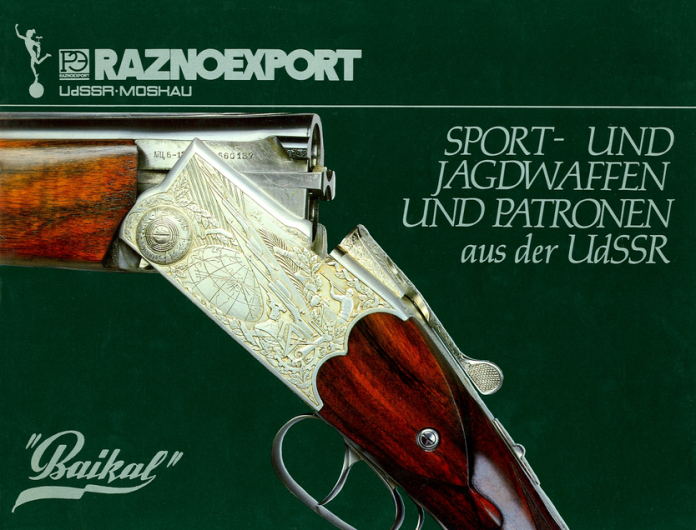
Late 1980s Raznoexport catalogue cover featuring 1966 vintage MTs 6.
Along the 1980s, with the combination of plummeting oil prices and the effect of economic sanctions, the Soviet economy was going from bad to worse to catastrophic. Soviet Government looked for sources of hard currency everywhere. However, there was a big problem. By 1990, as states a paper quoted by Egor Gaidar in his Collapse of an Empire (mandatory reading for everyone interested in the collapse of the USSR), only about 12% of Soviet manufactured products were competitive on the world markets (and for 47% of those overseas customers had serious quality complaints). Apparently, Soviet hunting shotguns were in the 12%, but their actual competitiveness is an open question.
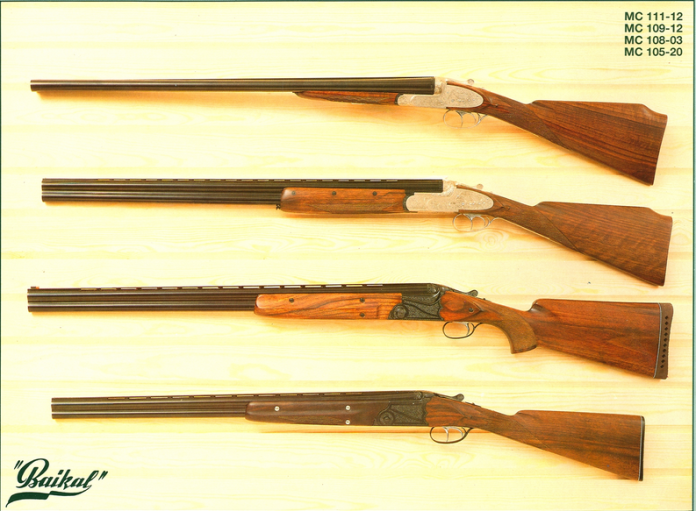
Various MTs guns offered by the catalogue.
The evidence of the frenzy with which Soviet trading companies tried to find export buyers is witnessed by the fact that most Raznoexport advertising material dates back to circa 1987-1989. A Raznoexport catalogue in German dating from the period is interesting in that a number of models in the catalogue are “phantom” guns, developed and announced but never made in large numbers. Those include TOZ-80, a reincarnation of the hammer double, and TOZ-84, the suggested replacement for TOZ-34, as well as the original version of Izh-43, featuring two single non-selective triggers, the front one firing right then left barrel, the rear one the other way round. On the other hand, TOZ’s 20-gauge bolt-action MTs-20, actually produced in volume, and a new gas-operated semi TOZ-87 are not mentioned.

“Phantom models” catalogued for sale in German-speaking countries.
On the other hand, the catalogue offers upgraded versions of TOZ-34 and Izh27 over/unders. This is an interesting thing, because whether higher grades of Russian guns were or weren’t available for export is a bit of a mystery.
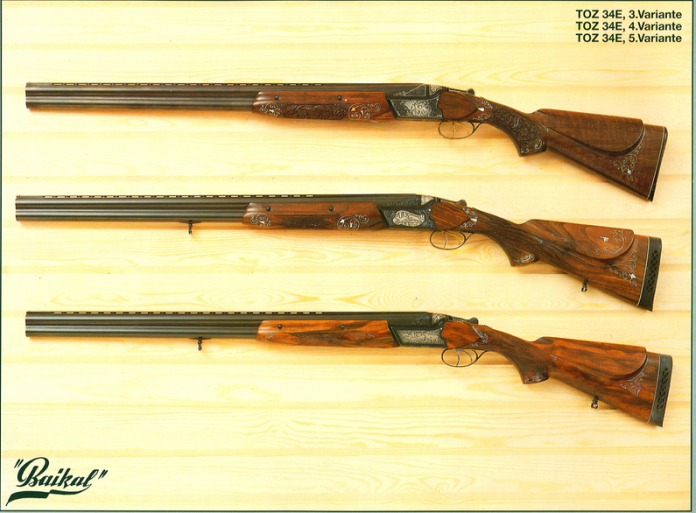
Various grades of TOZ-34 offered.
The catalogue, as I’ve already shown, does not fully correspond to the reality, and looks more like a rough and underdeveloped advertising copy. The final evidence is that the picture captioned MC110 actually shows Izh-27.
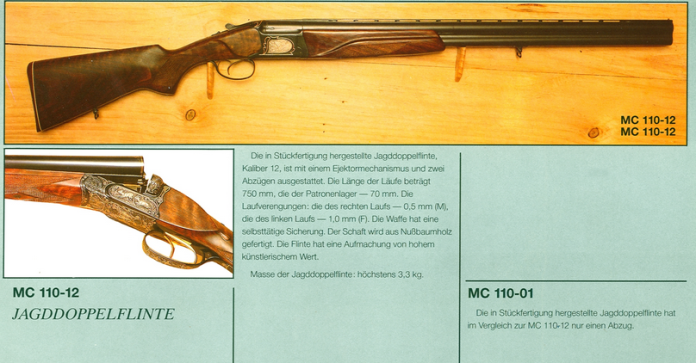
Page from Raznoexport catalogue showing Izh-27 captioned as MC 110
However, Soviet exporters faced a currency problem. The ruble was not a freely convertable currency, and its official exchange rate was set in 1961 at .61 RuR per USD and remained so until 1991. By mid-1980s, it was completely unrealistic; “special exchange rate”, introduced in the late 1980s, was 6.1 ruble per dollar, and on the black market a dollar cost 10 rubles a dollar. Overvalued ruble presented a big problem for the exporters, and they probably got around it by using clearance or barter schemes. Nikitas Kypridemos writes me that in Greece, at least, such a scheme was used, with products such as hunting guns and cameras supplied in exchange for citruses. That would allow to compensate for inadequate exchange rate by varying the amount of imported product – but it also meant that the producers couldn’t deal in their product directly, and in the reality of late-Soviet “economics of deficit” that would make them less motivated to work for export.
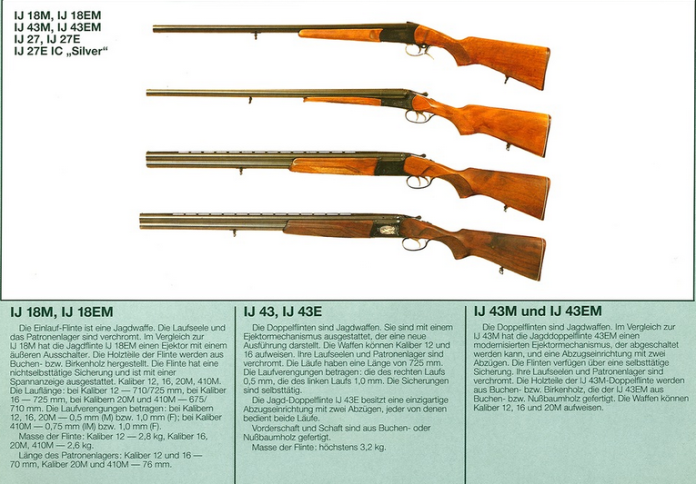
Izhevsk guns offered by the catalogue, including high-grade Izh-27 and “phantom” double-single-triggered Izh-43.
“Economics of deficit” meant if you wanted to buy some product that was in great demand you had to be friends with the salesperson, offer a service in return (e.g. “you sell me a color TV and I make sure your child goes to the university”), or pay a bribe. At the same time, economic reforms gave more freedom to producers, giving them more independence as to what to make, whom to sell and how to distribute profits – but not the price. In turn, traders who wanted a supply of deficit goods did so by offering the producers bribes or other incentives. Guns were in high demand, due to growing crime rates, emerging problems in many parts of the USSR (such as the Karabakh conflict between Armenia and Azerbaijan), and food shortages. Small wonder, then, that between 1988 and 1991 gun shops were swept clean of anything that could go bang as soon as it hit the shelves. In this situation, an Armenian or Azerbaijani trading cooperative, whose representatives would offer gifts of brandy, fresh fruit and other goodies not available in stores even before introducing themselves was much more convincing than a Raznoexport bureaucrat. Consequently, producers of sporting arms were much more interested in the local market than in the export.
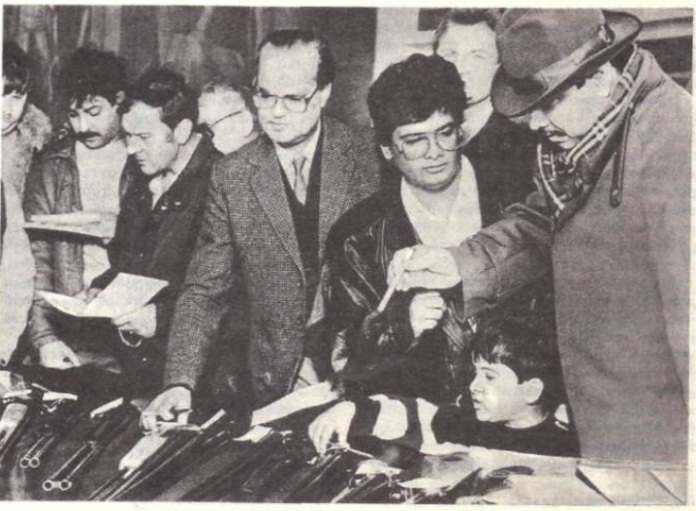
Customers looking at guns during 1990 Tula auction. From Ohota i ohotnichie hozyaistvo August 1990
The most interesting event of the period is, perhaps, the first (and, as far as I know, the last) gun auction held in Tula, USSR, on March 24 1990. All data I have on this comes from an article in “Ohota i ohotnichie hozyaistvo” (Hunting and wildlife management), August 1990. Over 600 participants, including the Ambassadors of Pakistan and Bangladesh, other diplomats, and businesspeople from Finland, competed for 104 guns and rifles of all grades, from cheapest workhorses to presentation grade MC bests. Overall there were 46 foreigners, who bought about a third of the lots. The most expensive and exclusive gun at the auction was an MC109 made to commemorate the 275th anniversary of Tula Imperial Gun Works. That gun featured relief game scene engraving, gold and silver inlays, gild triggers, carved stock with silver inlays, and a walnut carved case. With the starting price of 12,000 rubles it sold for 50,000.
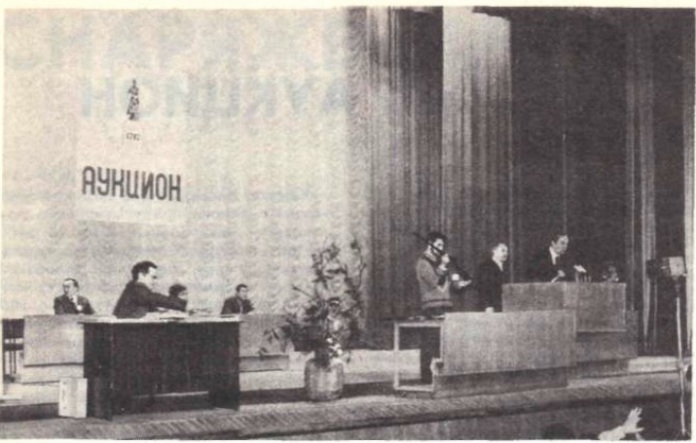
One of the lots auctioned. From Ohota i ohotnichie hozyaistvo August 1990.
I may cover this auction in more detail later, as I find many details of it very illustrative and characteristic of the period. The article mentions numerous hunters who paid a hefty sum of 20 rubles for the entry ticket in a desperate hope to buy a gun and pay a little over the official government price, maybe twice as much. But they were all disappointed – the hammer kept falling on five to ten times the shop price. In spite of government regulation of prices, the hidden inflation was mounting, Communist Titanic soon went under, and with it ended the history of Soviet gun export. What happened later is a totally different story.
P.S. As I’ve mentioned already, there are quite a few questions left unanswered:
– How many guns were supplied, and to what countries?
– What companies dealt in Soviet guns?
– How attractive were Soviet guns; what guns they competed against, what else could you buy with the same money?
– How many quality complaints were there and what?
– How did Soviet trading companies find their dealers?
– Were the dealers happy to work with their Soviet counterparts, were there any problems?
– What payment schemes were used (only clearance/barter schemes, or straightaway cash payments too)?
– Were Soviet guns promoted, and how?
This list is not complete, and you may add your own.
Some of the answers are waiting in the Raznoexport archives (provided they are not classified), others require a trip to the respective countries. But then again, are the answers going to justify the expense of time and money required to find them? Doubts… doubts… doubts…
Very intresting to know this information
LikeLiked by 1 person
Thank you!
LikeLike
MTs-24/TOZ-87 was not serial-produced until 1990, so it is not surprising. What happened to him then the first 12 years in fact… it’s a hole in the information.
Everything is strange with the MC-20, because judging by some magazines of the 80s, it was “produced” then only on paper, and again in some unknown single copies. I bet that they in fact appeared only with the advent of the folding-stock TOZ-106 or a little earlier.
LikeLike
This is a fascinating history of Russian hunting shotguns. Hope there is more to come.
LikeLike
Thank you!
LikeLike
I’d guess “bureaucracy” was a big hurdle back then, like “bureaucracy” is a big hurdle right now… at least when it comes to international sales.
As in, for a “foreigner” to buy choke tubes for a RMB-93 (Or RYS-K), it is next to impossible.
Russian shotguns have a strong following in Canada (whether they be the less-expensive work horse, or the higher quality stuff). Problem is, they are getting hard to find.
LikeLike
I really enjoyed reading about the history behind Baikal shotguns. I am new to shotguns and both of mine are Baikal ИЖ-18 models. I live in British Columbia (Canada) and have only seen or come across 4 Baikals types in the past year I have been aware of the brand – two which I purchased. I have read that here in Canada, Baikals are (or were) much more popular in Ontario and New Brunswick with hunters than elsewhere in the country and seem to have an excellent reputation. Usually the complaint about them is they look ugly but I love the look of Baikals. I have also noticed that often Baikals get misidentified as something else due to unfamiliarity with Cyrillic lettering (which I can read). One of my ИЖ-18 was listed as an MR-18 and NK-18. Soem dealers think IJ-18 and IZH-18 are different models, again not aware of the Cyrillic ИЖ lettering. Both of mine were excellent buys (under $200 CDN) for the condition but like all firearms here, their value is going up. Anyways, thank you for your very interesting and informative site as there seems to be very very little accurate info about the history of Baikal guns. Take care! ~DSC
LikeLike